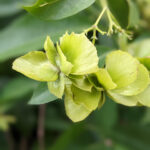Botanical Name/Etymology: Ilex vomitoria — The genus name Ilex is that given to all hollies. The specific epithet vomitoria is used in reference to the use of this plant by native peoples as a purgative (more about this below).
Common Name(s): yaupon, cassina, wild/native holly
Origin: North American native from Virginia and Florida in the east to central and south Texas in the west.
Growth Habit: 10’ X 6’ average, but can reach up to 25’ X 15’. Evergreen leaves that are alternate, simple, oval, or oblong and ½ to 1 ½ inches long. Crenateserrate scalloped margins. Leaves are glabrous, dark, glossy gray-green and are often copper colored when new. The females will produce red berries and the males will not (it is dioecious -the same case with all hollies), so a male in the vicinity is needed in order to fertilize the females to produce fruit.
Propagation: Seed (you may get male or female plants) or cuttings (which will give you a clone of the original).
Growth (Cultural) Requirements: Tolerant of a wide range of conditions – from sun to shade and from moist and heavy to sandy and well-drained soil. It is noted to be more tolerant of alkalinity than other hollies.
Plant Parts Used: Leaves contain a high level of caffeine, much like it distant cousin the yerba mate (Ilex paraguariensis) of South America. It is the only native to this region with that quality. The berries are toxic and should not be consumed!
Harvest: A mixture of younger and older leaves can be gathered in any season.
Uses: The leaves of this holly contain a high level of caffeine and were traditionally made into a beverage by the native peoples of the American South. To do this the leaves are roasted in an oven set to 200° until they are brown and dry. They can then be used to brew a tisane (herbal tea) or stored for later use.
Culinary Uses: The only culinary use is as a tea as mentioned.
Craft Uses: The berries of the female plant are beautiful and red and especially useful at the time of the holidays for decorating the home. Care should be taken with the berries as they can fall off and may be ingested by pets or young children and can have toxic effects. This is true of other hollies as well, including the possumhaw/deciduous holly which is also a beautifully decorative plant. As birds eat the berries, I assume that they are not toxic to our avian friends.
Other Uses: As mentioned above, native people previously used this plant to brew a drink which was used as a purgative in ceremonial rituals. It is believed that they would fast for days and then drink copious amounts of a tea brewed from the roasted yaupon leaves. The effect of large quantities of this tea on a virtually empty stomach caused a purging reaction. It is believed that other, more potent, plant materials may also have been utilized, but the yaupon is the plant that got stuck with the name “vomitoria,” and to this day many think that plant itself is toxic and would not venture to make a drink out of it. Its South American cousin, yerba mate, has become a very popular alternative drink to coffee. It will grow here as well, and we have some specimens in the Festival Hill gardens.
Quite a few variants in form are available, making this plant valuable in the landscape trade. There are dwarf forms, weeping forms, forms with yellow, white, or orange berries, and an upright form by the name of ‘Will Fleming’ – named after a local plantsman.
Henry Flowers, HSA Pioneer Unit Botany Study Group.
It is the policy of The Herb Society of America not to advise or recommend herbs for medicinal or health use. This information is intended for educational purposes only and should not be considered as a recommendation or an endorsement of any particular medical or health treatment.









